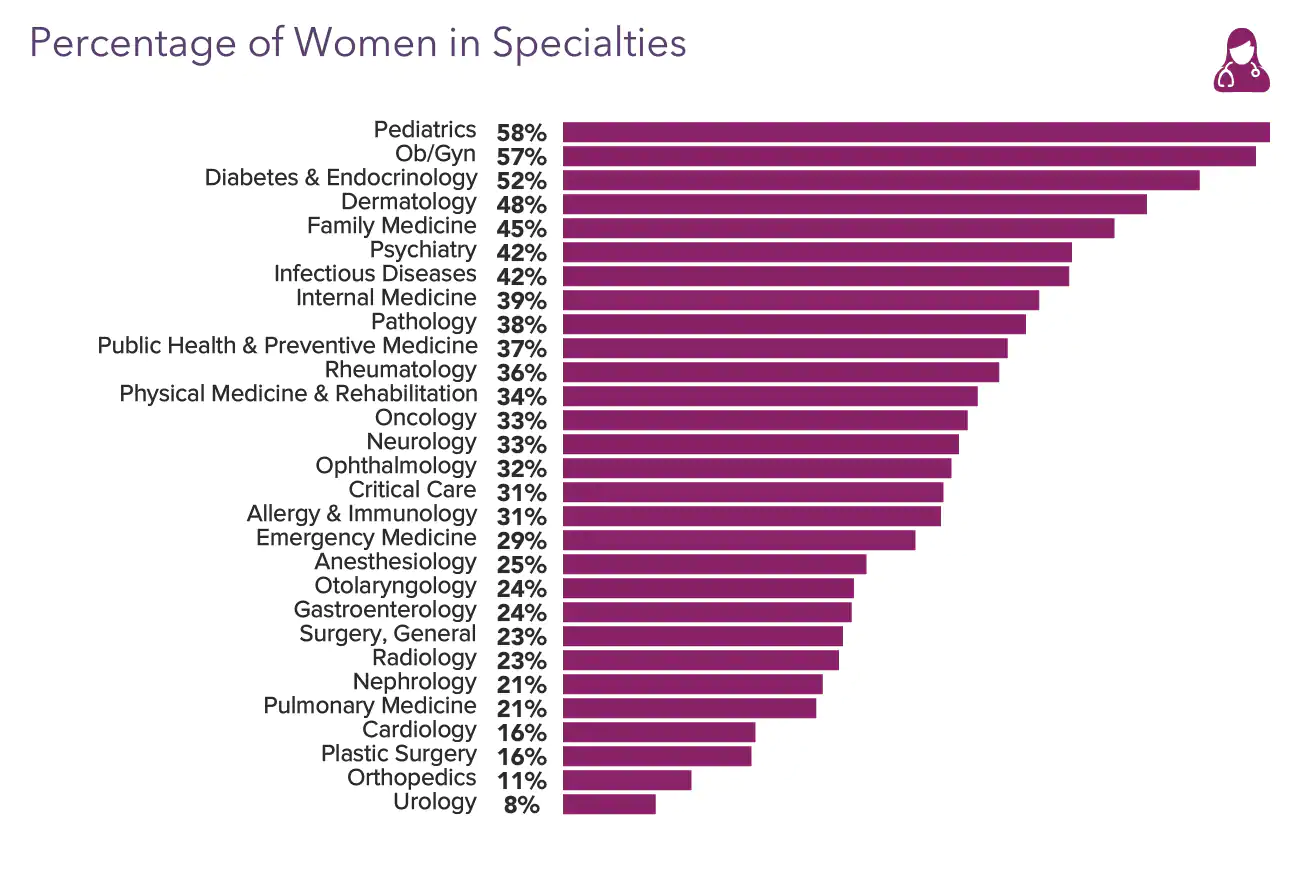Marketing to Doctors, Part 2: Messaging & Segmentation
Updated January 2023 with the latest statistics.
For others in the series click here.
When marketing to doctors, I see too many brands stumble over themselves with mediocre or mixed-up messaging. This is downright wasteful. As I explored in Part 1 of this series, it’s extremely hard/expensive to get a doctor’s attention.
Marketing to doctors is expensive. Once you DO have their attention, don’t blow it
Make the most of your opportunity by quickly giving physicians a brief, truthful, and relevant message about your product or service. This seems straightforward, and it is, but it’s amazing how many companies screw this part up while spending millions of dollars on wasted distribution and media buy.
To develop the most impactful messaging, you need to do a deep dive into both exactly who your audience is and what is important to them. From there, you can start to cherry-pick which of your potential brand messages will resonate with a given audience.
Want all the details on how to market to doctors?
Download our free 39-page eBook
Marketing to Doctors: A How-To Guide for Marketing Executives of All Levels
1. Tightly define your audience.
At glassCanopy, we often say that we “market to doctors” but the reality is that “doctors” is much too broad a category. “Doctors” is not a one-size-fits-all target audience.
There are over one million active physicians in the United States. Chances are, some of those physicians are better targets for your brand than others.
Specialty
Specialty should be one of the core pillars of your audience definition. It’s one of the primary ways in which physicians self-identify.
Almost all clinical, and most back-office, brands need to take specialty into account. Figure out which specialties your message is most relevant to and tailor your message to those specialities. If at all possible, don’t waste money and credibility by showing your message to irrelevant specialists.
Think specialty isn’t important to your marketing efforts because you’re targeting all doctors? Think again. Specialty has all kinds of implications for your target audience.
Even if all specialists are equally appealing to your brand (which is doubtful), the way that you might best appeal to them is likely to vary dramatically by specialty groups.
For instance, specialties correlate to:
Market Size. How many specialists are there in the US? There are approximately 500,000 active primary care physicians in the US versus 6,100 geriatric specialists. Need to know how many specialists there are in any given specialty? Check out this great resource from the American Association of Medical Colleges.
Decision Process. Do your specialists tend to work in independent practice or are they employees? According to the AMA, in 2020, ownership was highest among surgical subspecialties (61.5%) and lowest in emergency medicine physicians (27.9%).
Gender. Is there a strong gender bias in this specialty? While the 2021-2022 year was the first year, women became the majority of medical school graduates, in that same year only 37% of active doctors were women. Some specialties are much more slanted: nearly 60% of active OB/GYNs and pediatricians are women, but only 8% of urologists are female.
Income. Do your targeted specialists make more or less than the average among physicians? According to the 2022 Medscape physician compensation report, plastic surgeons took home $576,000 on average last year while public and preventative medicine doctors made less than half of that at $243,000.
Job Satisfaction. There are huge gaps between specialties. Just 63% of internal medicine doctors say they would choose that specialty again, while 99% of dermatologists would stick with dermatology.
Don’t hesitate to rewrite your pitch entirely to address different specialties—even if your product isn’t clinical in nature.
Setting
A pediatrician based in a giant urban hospital and a pediatrician working out of a small rural practice may both be treating kids every day, but virtually every other aspect of their professional lives is different. (Think about working at McCann Worldgroup versus a cozy boutique agency like glassCanopy.)
Hospital-based doctors may be actual employees of the hospital or they may be contractors, but either way, they have much less control over the day-to-day of their work lives than physicians who own their own practices.
Similarly, large-group and hospital-based physicians have a lot more resources at their disposal and don’t spend as much time thinking about the detailed financial aspects of their practice—whereas many solo GPs know their finances to the point that they could tell you how much they pay for a ream of paper.
Important settings to consider include:
- Government employees
- University or large-scale health organizations
- Hospitals/clinic-based practices
- Large groups (49+)
- Medium groups (10-49)
- Small groups (less than 10) and solo practices
In general, the smaller the organization, the more likely that physicians will find themselves taking on all kinds of non-medical-related jobs or decisions—from acting as informal IT support for staff to being effective heads of HR. Medical practices are consolidating but, as of 2020, 53.7% of physicians still worked in small practices of 10 or less.
The larger the organization, the more likely physicians will receive traditional defined benefits like paid time off, subsidized health insurance, dental plans, and life and disability insurance, as well as paid benefits like professional liability insurance or money for continuing education.
Geography
Geography may, or may not, be critical to your message, depending on your product/service.
Some instances of where geography often is critical are:
- Conditions being treated that primarily occur in specific areas
- Any product/service that is regulated by the state (or county) level
- Any product/service for which price or competition varies dramatically at the state or local level
Payment Model
It probably won’t surprise you that physicians act differently when they get paid differently. Traditional fee for service, accountable care, concierge service, HMOs, cash-only vs. private insurance-only vs. Medicaid/Medicare—all produce different incentives and behaviors.
Think about how the various permutations of compensation will make physicians likely to view your product or service. At the end of the day, the doctor’s compensation model impacts how your product/service gets paid for… and by whom.
When considering the impact of payment models, think about what models are most attractive to your brand, and also take into account other factors like specialty or geography that might correlate with those payment models.
2. Clarify what physician role(s) you’re appealing to.
Okay, so you’ve thought about which doctors you want to communicate with. Like everyone, doctors wear multiple hats, so let’s talk about in which role(s) you want to engage them.
There are three primary roles that marketers might want to appeal to:
A) The doctor-as-physician
Clinical marketing… aka marketing to a doctor in their role as a physician.
The primary goal here is not to “sell” the physician but to introduce your product and its potential benefits to the physician so that they can evaluate the benefits to their patients on their own. Allow doctors to validate claims for themselves by giving them access to the supporting data and studies, clinical experts with whom they can ask questions, and forums for discussion with colleagues.
All marketing should build trust. When marketing to doctors, trust is especially important.
It’s also worth noting that clinical marketing is a minefield of rules and regulations, so be careful about your both platforms and claims.
I’ll talk about the ethics and regulations of marketing to doctors in a future post, but in the meantime, please be sure that you stick to the golden rules:
- Keep patient safety and benefit at the top of your priority list. Yes, we live in a capitalist-based economy, but most people got into healthcare to help people. Don’t be the greedy asshole in the room.
- Don’t try to mislead the physician or make claims that you can’t clinically back up.
- Don’t try to bribe anyone.
- ALWAYS send EVERYTHING by legal to review
B) The doctor-as-business-person
In this era of ACA and consolidation, one fact often gets overlooked: As of 2020, only 44.1% of physicians had an ownership stake in their practice.
Even today… many doctors are also business owners.
What’s more, physicians typically effectively control most medical practices, even if they have hired business people to run the day-to-day.
And, even if doctors don’t directly own or control their practice, most physicians generally wield considerable influence in major business decisions.
When speaking to the physician-as-business-person, don’t make the mistake of thinking that this is ever the only hat that doctors wear. They’re still doctors, so economic arguments can’t ever be at the cost of patient well-being. (You still don’t want to be the greedy asshole in the room.)
Beyond a patient-well-being-comes-first attitude, prestige, pride, freedom, and all the other non-economic reasons people start businesses also apply to doctors. So go ahead and make your economic argument (you’ve got one, right?) to the doctor-as-business-person. But don’t make it the sole focus of your pitch.
C) The doctor-as-a-human
Studies show that 99.99% of doctors are actually human (margin of error is +/- .01%). They have lives outside medicine with husbands, wives, children, grandchildren, houses, mortgages, and/or maybe a flashy car or two.
Like everyone, doctors wish they had more time.
Many (but not all) have considerable disposable income. Remember that there is a wide variance between physician income by specialty and geographic region. For instance, according to a 2022 Medscape study on physician income, Kentuky physicians were the top earners nationwide and averaged $364,000 while District of Columbia doctors squeaked by on just $232,000.
What’s the point here? Yes, being a doctor is a vocation and a central self-defining aspect for most doctors, but doctors are still mothers, fathers, runners, glassblowing enthusiasts, and stamp collectors too. If you’re selling to doctors-as-people, keep that in mind.
That’s a lot of variables.
I know, right?
You need to think through all these variables and then figure out how/when you can clump them together to create a manageable number of segments.
Keep in mind that the expense involved in physician marketing means that it’s often worth developing creative and campaigns for smaller target segments that would be worthwhile in less competitive markets.
Hopefully, this will provide some food for thought the next time you sit down to think about your messaging and segmentation. In next week’s post, we’ll discuss some of the ways to target specific sub-segments of physicians.
This is the second of a multi-part series on marketing to doctors.
Why marketing to doctors is so hard.
Content marketing and development
Measuring and optimizing results




